IN THIS ISSUE
- Rattlesnake survival story
- Rare birds back at Sprewell
- More whale calves (and video)
- How wildlife look at mistletoe
 The indigo and its prey, plus a closeup and the rattlesnake in recovery (Matt Moore/DNR)
This is the tale of the Jonah rattler.
Or, as Matt Moore describes it, a story with “layers of unlikeliness.”
As part of a survey for federally protected eastern indigo snakes, the DNR wildlife technician caught a relatively small but rather stout indigo crossing a Long County field last month. He measured and tagged the roughly 4-foot-long snake, then put it in a cloth bag for weighing.
Nothing seemed out of order. Until he opened the bag. That's when, as Moore said, "things kinda got weird.”
The bag now held three snakes: a slimmer indigo, a young adult rat snake and a juvenile eastern diamond-backed rattlesnake. The indigo, a species whose prey includes snakes, had regurgitated the others. "It was filled to the brim with snakes,” Moore said.
Both regurgitated snakes were dead. Or appeared to be.
While surprised at the extra reptiles – Moore had heard of indigos upchucking partially digested snakes, though never a venomous one – he carefully moved the rat snake and 14- to 16-inch-long diamondback to a table. Within minutes, he noticed the rattler’s tail twitch. Just a remnant muscle contraction, Moore thought.
He put the remains in a bag and finished processing the indigo. But when he went back an hour and a half later, the diamondback was crawling.
Indigos are voracious predators. They grow up to about 8 feet long, are immune to the venom of native snakes and eat “pretty much anything made out of protein.” Moore explained that indigos kill other snakes by chewing their head, crushing the skull and then swallowing the animals whole.
This indigo just didn’t finish the job. The skin on the rattler’s head was only slightly torn. Moore thinks he caught the indigo just after it ate the rattlesnake. The dead rat snake had been digested longer.
Thankful that he wasn’t bitten by the temporarily comatose rattler, Moore released the revived reptile at a gopher tortoise burrow, a common refuge for the species. Yet after crawling into the entrance, the rattlesnake came out and began to bask in grass nearby. Moore had never seen a diamondback shun a burrow.
Oh, and one last layer of unlikeliness: A bulge in the rattler’s body showed it had recently eaten a big mouse.
"It managed to keep its meal down after being swallowed and regurgitated by the indigo,” Moore said.
HEAVY EATER
The indigo weighed 2.1 pounds with its prey and 1.7 pounds without. It had consumed just less than a half-pound in snakes, a quarter of its weight.
GOING FORWARD
Although the rattlesnake initially survived the indigo encounter, it might later succumb to the wounds suffered. If not, and Moore sees the rattler again, the snake could be identified by its scarred head and unique dorsal pattern. Stay tuned.
 Coming soon to georgiawildlife.com: a statewide look at wildlife conservation in fiscal year 2023.
The annual account of work done by DNR’s Wildlife Conservation Section and partners ranges from restoring gopher tortoise populations in south Georgia and surveying bats in mountain caves to monitoring priority species such as red knots, tangerine darters and Tennessee yellow-eyed grass.
The summary 2023 report is already available. An in-depth version will be posted this month, in flip-page and downloadable formats.
The Wildlife Conservation Section’s mission is conserving native Georgia wildlife not hunted or fished for, plus rare plants and natural habitats. Yet the agency depends largely on fundraisers, grants and contributions. Here's how you can help.
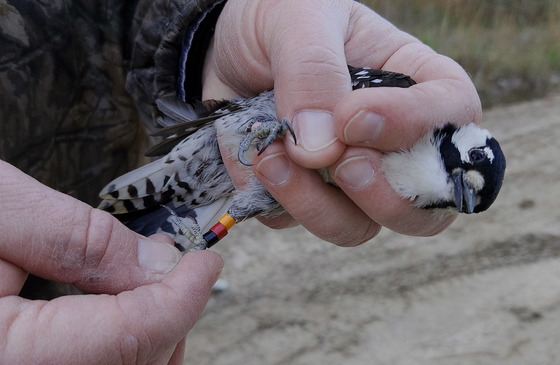 Fort Stewart red-cockaded woodpecker bound for Sprewell Bluff (Santiago Lepper/Army Public Affairs)
On a chilly morning last week, the sharp-pitched chattering heard at dawn in a Sprewell Bluff pine stand might have seemed inconspicuous. But to DNR senior wildlife biologist Nathan Klaus, it was the sweet sound of a conservation success.
Red-cockaded woodpeckers were back at Sprewell Bluff.
The endangered birds hadn’t been documented at the middle Georgia wildlife management area for nearly 50 years. But following years of work at the WMA to restore longleaf pine savanna beneficial to this species and other wildlife – much of that work led by Klaus – three pairs of red-cockaded woodpeckers were moved overnight from Fort Stewart near Hinesville, placed in nest cavities chain-sawed into mature pines at Sprewell Bluff (watch) and released at sunup the next morning.
The hope is the newcomers stay and begin nesting next spring.
Klaus said red-cockaded woodpeckers are emblematic of longleaf pine forest. Yet Georgia has lost 97 percent of this ecosystem over the last 150 years, and much of what remains is degraded, in large part because the regular fires these woodlands require have been suppressed.
 DNR's Nathan Klaus watches the newly released woodpeckers on the WMA (Ethan Hatchett/DNR)
“What happened at Sprewell Bluff this week was not just the beginning of hope for that tract but the start of something even bigger, the full recovery of that ecosystem," Klaus said. "The return of red-cockaded woodpeckers to the wild landscape where they once lived is like having the heart of Sprewell Bluff begin to beat again. It was truly a sacred moment for me, something that I have hoped for and worked toward for more than two decades.”
Partners in the recovery effort at Sprewell Bluff include Georgia Power, Upson County, Georgia Ornithological Society, The Nature Conservancy, the National Fish and Wildlife Foundation, the Knobloch Family Foundation, PotlatchDeltic (formerly involved as CatchMark Timber Trust) and Weyerhaeuser.
Moving the woodpecker pairs from Fort Stewart, an Army base with a healthy red-cockaded population, was coordinated through the Southern Range Translocation Cooperative. This group of government agencies and private organizations focuses on expanding and strengthening the species’ numbers.
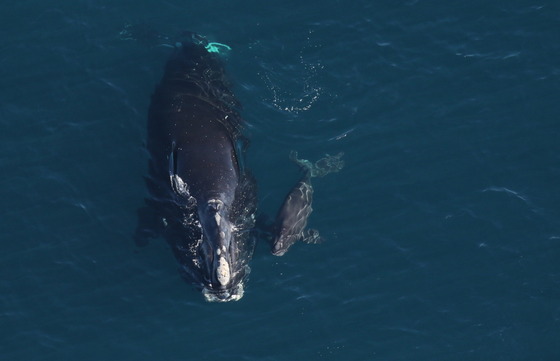 Right whale Horton and calf off Georgia's coast (CMARI/NOAA permit 26919)
And then there were three. At least that was the most recent total for North Atlantic right whales.
The calving season’s third mom and calf were spotted off South Carolina Saturday. This is the fifth documented calf for right whale no. 1970 – more than 35 years old and nicknamed Palmetto (for callosities on her head resembling a palm tree and because she rarely swims farther south than South Carolina). The calf count is also welcomed news for an endangered species desperately needing a surge in births.
Only about 350 North Atlantic right whales are left. That makes them one of the world’s most imperiled large whales. And the waters off Georgia, northeastern Florida and the Carolinas are their only known calving grounds.
The season’s first mom-calf pair made it to Georgia Dec. 4. A DNR boat crew took drone video after a survey flight spotted Juno and her less than 2-week-old calf about 7 miles off Sapelo Island. The pair was first seen in South Carolina waters.
The second duo, right whale 3360 (Horton) and her third known calf, was spotted by aerial observers 22 miles off St. Catherines Island on Dec. 7.
WHAT YOU CAN DO
-
When boating off Georgia’s coast from November to April, follow guidelines for navigating in right whale waters. The Whale Alert app can show whales in the area.
-
Report sightings via 877-WHALE-HELP (877-942-5343) or the U.S. Coast Guard on marine VHF channel 16.
-
Learn more about these whales and the work to save them. As a starter, follow DNR’s marine mammal team in “A Right Whale Season” on the Georgia wildlife blog. First up: a promising start and Juno's tie to Roman culture.
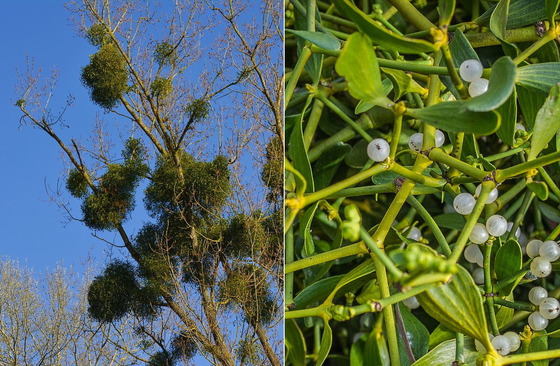 Mistletoe and its berries (image on right/Pixabay.com)
By TERRY W. JOHNSON
Mistletoe is a curious plant. We all recognize it as one of the handful of plants we associate with Christmas. (Believe it or not, the practice of adorning homes with mistletoe sprigs stems from ceremonies practiced by the ancient Druids.)
Yet, at the same time, mistletoe is also a valuable wildlife food plant, beloved by insects – including the stunning great purple hairstreak – birds and even deer.
Which begs the question: How can a parasitic plant that grows in the tops of hardwood trees be either? ...
Read Terry’s Out My Backdoor column for a new perspective on mistletoe.
Terry W. Johnson is a retired DNR manager and executive director of TERN, friends group of the Wildlife Conservation Section. Check out past columns and his blog. Permission is required to reprint a column.
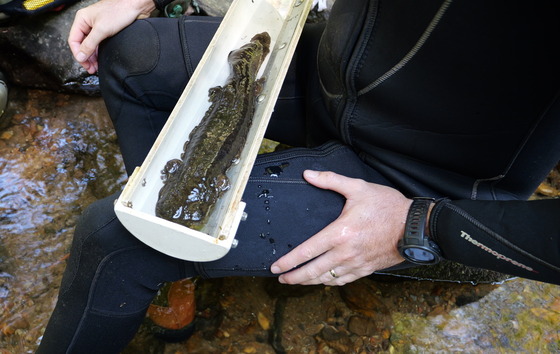 A hellbender caught, checked and released in north Georgia (Erika Noriega Torres/DNR)
Eastern hellbender surveys this fall found 14 of the big and rare salamanders across eight north Georgia streams, including one population that had not been documented in almost 20 years. The search led by DNR wildlife biologist Thomas Floyd also drew an audience on social media and traditional media.
Nearly 500 hooded pitcherplants and other wetland-seep species threatened by road construction near Valdosta were dug up and saved for planting elsewhere in a rescue involving the Georgia Native Plant Society, the Georgia Department of Transportation and DNR. Although Sarracenia minor is considered secure in the state, much of its habitat has been destroyed and many older populations lost.
 Grant work will help boost stream connectivity for federally threatened trispot darters (Ani Escobar/DNR)
A new DNR-guided project will improve stream connectivity for trispot darters. Recently awarded a $2 million grant from the National Fish and Wildlife Foundation, the work planned with The Nature Conservancy and Limestone Valley Resource Conservation and Development Council will document spawning grounds in the Conasauga and Coosawattee River watersheds, assess hundreds of road crossings for issues they pose the threatened fish, and fix some of those barriers.
Other America the Beautiful Challenge grants involving Georgia include $2.5 million to improve wildlife habitat on 42,000 acres of longleaf pine woodlands here and in the Carolinas and Florida, plus $293,000 for the Georgia Forestry Foundation to provide technical assistance to minority and small landowners in gopher tortoise and bobwhite quail priority regions. The N.C. Wildlife Resources Commission received the first grant.
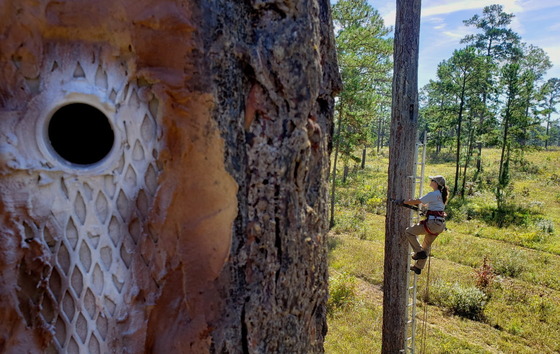 Within sight of one nest insert, DNR's Christina Lokey replaces another in the Red Hills (Robert Myer/Tall Timbers)
Far south of Sprewell Bluff, another milestone for red-cockaded woodpeckers is within reach. According to a recent assessment, there are 269 red-cockaded territories in the Red Hills region of south Georgia/north Florida, including 210 with breeding pairs – only 40 pairs shy of the 250 goal set by DNR and the conservation nonprofit Tall Timbers.
Add blue land crabs to the lineup of invasive species crawling our way. The large non-native crustaceans with carapaces up to 6 inches have been reported along the South Atlantic coast, including in Georgia, spurring DNR to ask the public to take photos and report sightings.
 See a wintering monarch; report it via Journey North (Denise Shepherd/DNR)
Quick hits:
- The watch is on again for monarchs wintering in the Southeast, with a regionwide call to log sightings of the butterflies proposed for Endangered Species Act listing.
- A partner-powered project added 2,000-plus acres to Dawson Forest Wildlife Management Area near Dawsonville, more than tripling the state conservation lands around Amicalola Falls State Park.
- Georgia Water Coalition’s 2023 Clean 13 report spotlighting leaders in protecting water resources includes the Partnership for the Upper Coosa and the Utility Scale Solar Siting Initiative, among others.
- A weekend Becoming an Outdoors-Woman workshop last month at Charlie Elliott Wildlife Center fielded 94 women, the Mansfield center’s largest ever for the program engaging women in outdoor recreation.
- The new River to Clouds Route trail, open to everything from hiking to mountain biking, reaches from the Chattanooga, Tenn., riverfront to Cloudland Canyon State Park, with the Cloudland Connecter Trail making up 18 of the system’s 34 miles.
Names in the news: Georgia Audubon is now Birds Georgia. The new name mirrors changes by some other independent National Audubon Society chapters to distance themselves from namesake and 19th-century artist John James Audubon, who has a racist legacy and whose bird work is unknown to many. U.S. Rep. Buddy Carter and the Coast Guard’s 7th District Command recently presented Meritorious Service awards to the DNR Law Enforcement Division's Sgt. Mark Carson, Cpls. Jay Bright and Thomas Shaske, and game warden Zac Griffis for their work as first responders when the Golden Ray capsized in 2019. Interest in “Longleaf Forever” is increasing. The short documentary by Magic Kumquat Productions on longleaf pine ecosystems has been screened or accepted at more than seven film festivals this year or in 2024, with the Wildlife Conservation Film Festival including a virtual version (pass required).
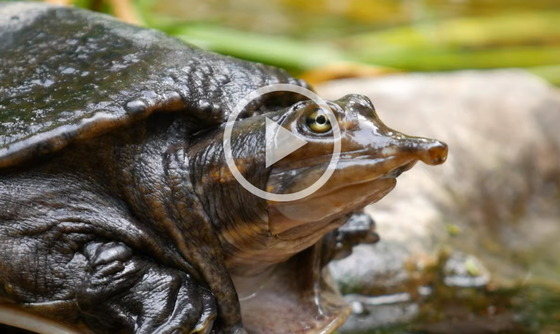 “Georgia’s Amazing Freshwater Turtles,” DNR. (Wildlife biologist Thomas Floyd explores Georgia’s rich turtle diversity, explaining how geology, river systems and ample rainfall make this state one of the world's best places for freshwater turtles.)
Berry bald eagles hard at work prepping nest, Berry College. (PS: The birds now have two eggs. Updates on Facebook.)
Bobwhite quail survey, DNR
DNR commissioner on guarding against Chronic Wasting Disease, DNR
“Video shows three humpback whales jump in unison,” Associated Press
"Protecting at-risk plants, animals must start before they need ESA," Scientific American
(+video) "First right whale calf of season spotted off Georgia, S.C. coast," WJCL-TV (Savannah). Also: WSAV-TV (Savannah), The Brunswick News and others.
"Scientists: high level of whale activity off Maine coast," Connecticut Public Radio
(+video) "Endangered woodpeckers get new (old) home at Sprewell Bluff," The Atlanta Journal-Constitution. Also: DVIDS.
"Tegus in Georgia: What to know about ‘giant lizard’ invasive species," WSB-TV (Atlanta). Also: CBS News and others.
"Winter watch: Project seeks monarch sightings in Southeast," Chattanoogan.com. Also: WJAX-TV (Jacksonville, Fla.), Atlanta News First and others.
"Dozens of suckers but no shoal bass: What fish tell us about Chattahoochee," Georgia Public Broadcasting
(+audio) "As Endangered Species Act turns 50, Georgia searches for populations of elusive salamanders," WABE-FM (90.1, Atlanta)
"Wanted: Proposals for DNR wildlife-viewing grants," The McDuffie Progress. Also: Albany Herald, AllonGeorgia and others.
(paywall) "Why this Houston County naturalist is fighting a solar farm," The (Macon) Telegraph. Also: "Naturalist speaks out against proposed solar farm," The Houston Home Journal.
"A solar future where people and nature thrive," SaportaReport
"2 more endangered Florida panthers struck, killed by vehicles," Associated Press
"State's wild turkeys, once conservation success, now in decline," Georgia Recorder
"Wildlife-vehicle collisions study delves into factors detecting animals after dark," Phys.org (study)
(+video) "Alligator trappers find, kill 12-foot python in central Florida," WOFL-TV (Orlando, Fla.)
"Rebuilding oyster reefs on Georgia coast could help fight climate change," WABE-FM (90.1, Atlanta)
"Cam in tortoise burrow shows rattler roommate," Georgia Public Broadcasting
"Guided forest bathing along Chattahoochee," The Atlanta Journal-Constitution
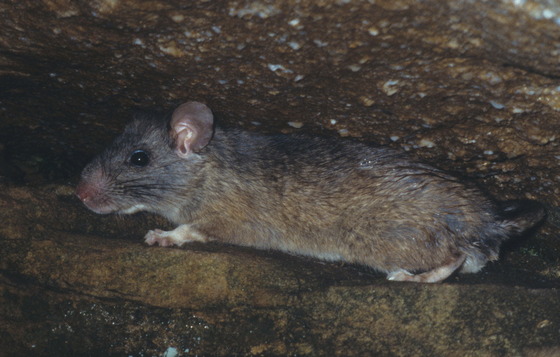 Woodrat (Steven Castleberry/UGA)
Winter is a time to huddle in our homes and enjoy delicious homemade meals. The same holds true for eastern woodrats. These native rodents, often called pack rats, store food in large dens made of sticks to help them survive winter. Woodrats even decorate their homes with shiny non-edible items such as candy wrappers, jewelry and spent shotgun shells. The structures not only provide a secure place to forage from year-round, they sometimes house other small animals like lizards and frogs.
- Ethan Hatchett
CREDIT
Masthead: tangerine darter (Isaac Szabo/Engbretson Underwater Photography)
Top
|